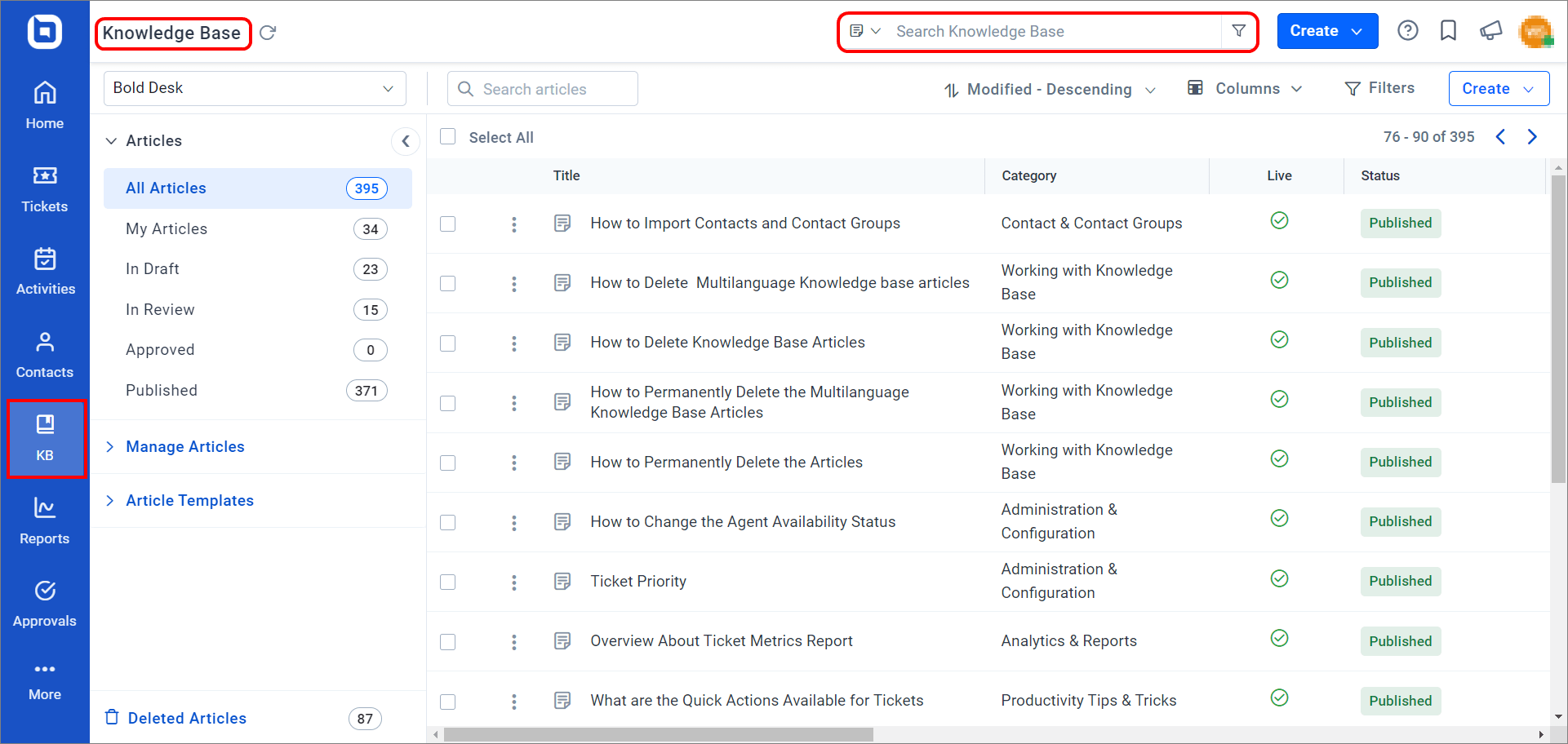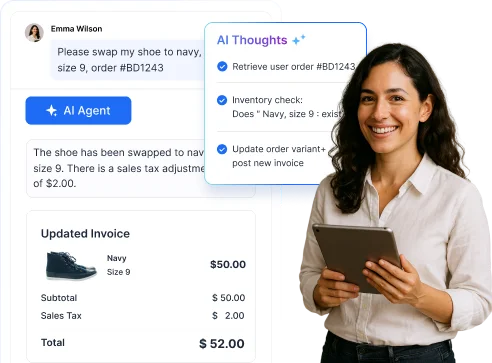Imagine this: a customer reaches out to your customer service with a product issue or a bug and finds your team busy with higher-priority tasks, yet they have a lot of questions and insist on being helped immediately.
Instead of pointing the customer to a faceless FAQ page or leaving them on hold in despair, your knowledge centered service-trained team is ready for the task.
With a step-by-step knowledge centered service guide and tips, your customer service team uses relevant articles and guides to transform the customer from frustrated to highly satisfied.
This is the type of world-class support experience you can build.
Dive into our guide to learn the essential steps to implementing knowledge centered service in your organization.
What is knowledge-centered service?
Knowledge-centered service (KCS) is a methodology that enables customer service teams to create solutions, structure information, share knowledge through a centralized repository system, and use that knowledge to solve problems faster and improve customer and employee satisfaction.
Knowledge centered service emphasizes knowledge as a critical asset for delivering service and support.
The major beneficiaries of knowledge centered service are:
- Customers: Customers can access helpful step-by-step guides and tips to handle their issues. No more waiting on hold!
- New employees: New recruits level up their skills in a flash by learning from all the information already available.
- The business: Support agents share their wisdom and experiences by creating resources for internal and external use, making things smoother for everyone. Plus, when agents have answers on hand, they spend less time repeating themselves, which means more time for high-priority tasks!
KCS is all about using your team’s knowledge to provide amazing customer support.
How does knowledge centered service (KCS) work?
Knowledge centered service works by integrating a knowledge management system, such as a knowledge base, into your support processes.
The key is to create resources as you solve customer issues, and then structure and publish those resources in a knowledge base. Reuse and improve those resources over time.
To get started, identify common questions and time-consuming problems your team frequently deals with. Each one is an opportunity to build knowledge that helps both customers and support agents.
After identifying an issue, check if there’s already an article in your knowledge base that addresses it. If there is, provide that information to your customer.
If there isn’t, solve the problem then write up the steps you took. Keep the wording simple and easy to follow. Mention any roadblocks or gotchas to watch out for.
The key to successful knowledge centered service is making knowledge sharing a habit. Take a few minutes after each tricky case to capture what you’ve learned.
Over time, you’ll build an impressive library of self-service content. Your customers will appreciate the in-depth support, and your company will benefit from more efficient service.
Why knowledge centered service is important
Knowledge-centered service provides numerous advantages to not only your support team, but your entire organization.
Here are some of KCS importance:
Speeds up knowledge creation
As agents solve customer issues, their solutions are captured and added to the knowledge base in real time. This means new solutions are constantly being added, without agents having to spend extra time documenting them.
Reduces issue handling time
With a robust knowledge base, agents don’t have to spend time researching solutions or asking other team members for help. They can find answers in just a few clicks and provide customers with quick resolutions.
This decreases the time spent resolving each ticket, allowing agents to handle more tickets.

Improves customer satisfaction
With knowledge centered service, customers get faster and more accurate responses because agents have the information they need at their fingertips.
As a result, customers are happier and more loyal. According to McKinsey, excellent customer experience can boost sales revenue by 2-7% and enhance profitability by 1-2%.
Reduces training time for new agents
knowledge centered service gives new agents the ability to tap into the collective knowledge of more experienced agents and get up to speed quickly. This enhances onboarding, thus minimizing agent training time and reducing training costs.
Improves first contact resolution
When agents have the knowledge they need at their fingertips, they’re able to resolve more customer issues on the first contact. This means fewer escalated tickets, less back-and-forth communication, and fewer repeat contacts from frustrated customers.
Effortless scalability
Having effective knowledge centered service also allows support teams to scale without compromising quality.
As the volume of customer contacts increases, agents can continue to provide fast, accurate service by leveraging the collective knowledge of the team.
Support teams can then grow efficiently without lengthy onboarding or extensive training for new agents.
Key principles of knowledge centered support
While offering knowledge centered service, there are different principles that guides businesses throughout the process. These include:
- Capture knowledge from every interaction: Record solutions in clear, simple words so others can understand and reuse the information. Make sure all common customer problems can be solved with the knowledge base.
- Arrange information in a centralized repository system: Organize content so customers and agents can easily search for and access what they need. Consider how customers will search for and use the information.
- Continuously improve and update your knowledge base: Update content with the most recent customer queries and articles to keep it relevant and helpful. Get feedback from users and make changes to reduce repeat contacts and frustration.
- Track key performance metrics: Continuously track key performance metrics like customer satisfaction scores, page visits, top visited articles, failed searches, and feedback on knowledge base pages to improve knowledge centered support implementation.
These principles, when put into practice, can significantly improve your support outcomes.
A knowledge-centered approach leads to faster issue resolution, reduced handle times, and higher customer satisfaction.
Best practices for knowledge-centered support
The key to a successful knowledge-centered service team is establishing best practices and sticking to them. Here are some tips to get you started:
Document knowledge from every interaction
Make it a habit to document every interaction with customers, not just the ones dealing with complex issues. The small details matter and may come in handy down the road. Keep records of:
- Common questions and problems
- Known issues and workarounds
- Time-consuming or frustrating topics for customers
Embrace knowledge sharing among teammates
Knowledge management isn’t a one-person job. Encourage your team members to work together by:
- Reviewing and improving each other’s content
- Sharing effective responses or solutions they’ve discovered
- Discussing trends in customer questions or feedback
Fostering an environment of openness and teamwork will lead to a robust and useful knowledge base.

Analyze and track your knowledge base data
The only way to improve is to understand what’s working and what’s not. Analyze things like:
- Article views and search trends to see popular topics
- Escalation rates and handle times to find knowledge gaps
- Customer satisfaction scores to determine overall effectiveness
- Agent feedback on what they need to do their jobs well
Make changes based on the insights you uncover and then measure again. Continuous improvement is key.
Review and improve knowledge base continuously
Regularly review, verify, and update knowledge articles to keep information accurate and helpful. Monitor search trends and feedback to see what’s working and make improvements.
Establish clear processes for creating, organizing, and maintaining your knowledge base content. Things like:
- Using templates for different content types (FAQs, troubleshooting guides, etc.)
- A consistent taxonomy or categorization system
- Regularly reviewing and updating older content
- Archiving or removing outdated, irrelevant information
Standardizing your approach will make life easier for both customers and agents. Focus on consistency and efficiency.
Organize the articles for easy access
Structure knowledge in a searchable format, like an online knowledge base. Categorize articles and include meaningful titles, tags, and summaries so agents and customers can quickly find what they need.

Challenges of KCS
Implementing knowledge centered service comes with its fair share of challenges. Some of them are:
- Many organizations struggle with a knowledge hoarding culture in which agents are reluctant to share what they know.
- Some teams lack dedicated resources and ownership over knowledge management, viewing it as extra work.
- Outdated tools and manual processes can make contributing to and finding knowledge difficult and time-consuming.
To overcome these roadblocks:
- Start by promoting a culture where sharing knowledge is valued and rewarded.
- Assign clear ownership and accountability for knowledge creation and maintenance.
- Invest in tools that streamline the discovery and contribution process, integrating knowledge into your daily workflows.
- Little by little, adopt an “all teach, all learn” mindset where everyone, regardless of role or tenure, is both student and teacher.
With the right mix of people, process, and technology, you’ll be providing knowledge-centered service in no time.
Empower your agents with knowledge centered service
In summary, knowledge centered support should be a top priority for any company focused on delivering amazing customer experiences.
When agents have the knowledge and tools to quickly resolve issues, customers win with fast and accurate solutions. On the other hand, support teams win with improved efficiency and scalability.
Try using BoldDesk, powerful help desk ticketing software that provide tools to improve your knowledge centered service. Schedule a 30-minute live demo or start a 15-day free trial to experience its powerful knowledge centered support features. To learn more and get started with BoldDesk, contact us.
Wait! This article isn’t a one-way street. We want to hear from you!
Share your experiences with knowledge centered service and ask questions in the comment section below.
Related articles



















 Email Ticketing System
Email Ticketing System Shared Inbox Software
Shared Inbox Software Multi Brand Help Desk
Multi Brand Help Desk Internal Help Desk Software
Internal Help Desk Software Trouble Ticketing Software
Trouble Ticketing Software Mobile Help Desk
Mobile Help Desk 















